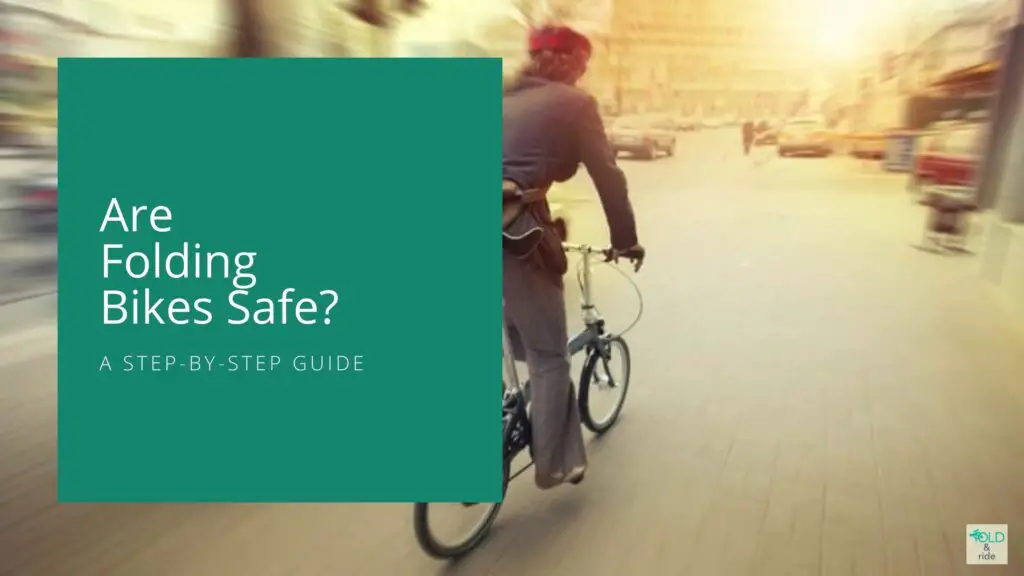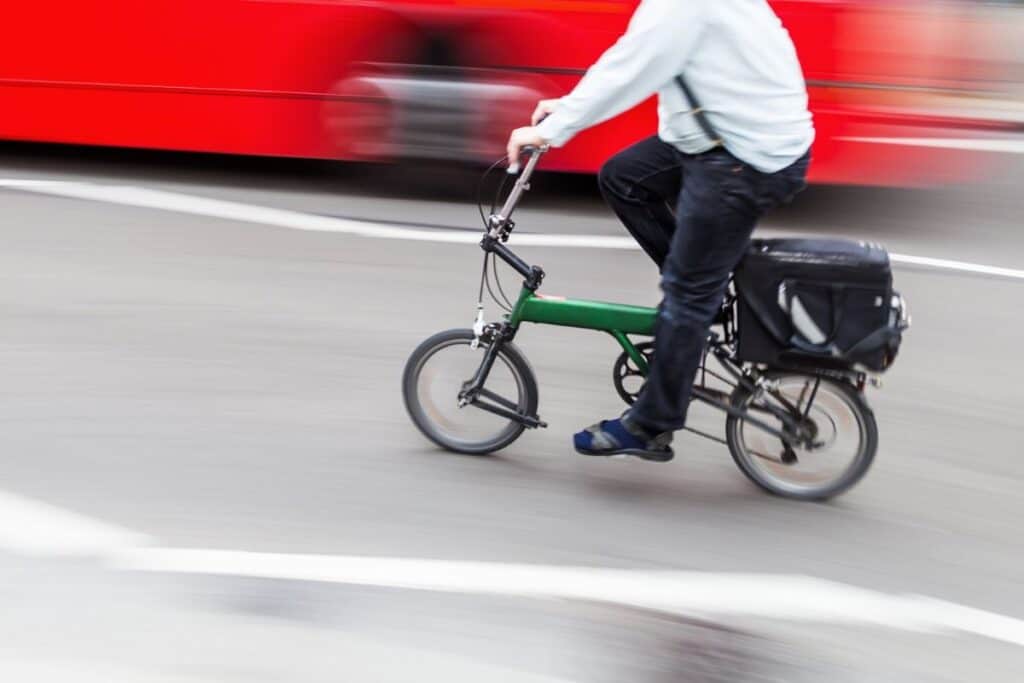Folding bikes often come under quite a bit of scrutiny and strong public opinion, most of which is usually unjust. The most popular opinion against the use of a folding bike is that they are considered to be ‘unsafe’.

As an Amazon affiliate, we earn from qualifying purchases.
This opinion is usually based on an exaggerated story that someone has heard about these bikes breaking in half or collapsing on themselves while someone is riding it. This opinion has led us to research just how true these rumors are and whether folding bikes are actually safe to ride?
Folding bikes are just as safe to ride as any other type of bike including road and mountain bikes. Folding bikes are subject to rigorous safety and construction testing by the manufacturers to ensure that they are strong and safe. A bike that breaks easily would not give a good impression for a specific brand and could result in bad publicity or even legal action if a faulty model led to an accident. Therefore, folding bikes are manufactured to a high safety standard just like any other bike.
Whilst folding bikes have seen a huge boost in popularity in recent years, you’ll find that what was once a novelty bike has now become a lighter, stronger and more compact model that is seen in major cities around the world.
The key when it comes to folding bike safety is to first understand why people consider them to be unsafe.
Why Are Folding Bikes Considered Unsafe?
There are two main reasons why people consider folding bikes to be unsafe and both revolve around the latch, hinge or joint that allows these bikes to be convenient and portable (which happens to be the main selling point and what makes these bikes so popular).
Without getting too technical about the mechanics of shock absorption and force distribution (there’s a great article on how this impacts the durability of a bike here), it’s important to note that any areas of stress on a bike will result in a weak point that could be susceptible to breaking.
If the hinge on the bike is placed in an area that comes under a significant amount of stress during a ride (mainly directly underneath the rider’s weight or at the front end of the bike) then it will pose a significant weak point in the bike’s structure.

While it’s true that in the past when these bikes first came onto the market, they were more of a novelty item. The manufacturing and design process for these were far from optimal as companies were instead looking at ways to make road bikes lighter and faster or improving the suspension on mountain bikes.
Therefore, we can see that initially, folding bikes may have had a few structural issues in their design. A cheaper model would certainly be at risk of easily breaking or collapsing on itself mid-ride, however, the standard and quality of a folding bike today is so high that the price actually exceeds that of a standard road bike!
The key behind this increase in folding bike quality comes down to the specialist brands that are constantly innovating and making these bikes more and more popular in urban areas.
Brand Reputation
Brompton, Dahon and Tern are the market leaders when it comes to folding bikes and while you’ll find a range of prices when looking into their models, one thing that is certain is that they all provide high quality bikes. If you are concerned about bike safety then purchasing one from a leading brand is a great first step.
With any model bike, you’ll find that the more expensive models typically offer the most features, durability and highest quality of the material. The high prices however are not the result of a marketing or branding effect, when it comes to bikes the higher quality material the more expensive the bike.
To make a truly durable bike you need a more advanced manufacturing process, a light frame that also has tensile strength is not something that can be made cheaply.
Therefore, you’ll find that folding bikes will typically have a higher price range than a road bike because there is an expectation for them to be light and portable whilst also strong and durable (not an easy combination).
Unfortunately, when it comes to folding bikes, if you are looking to save money and take the bargain route then you risk sacrificing quality and durability. A second-hand bike from a leading brand can be a good way of getting a folding bike at a bargain price but a cheaply made folding bike is not something we could easily recommend.
The leading brands have invested a lot of money into researching, designing and manufacturing their folding bikes and if there was an issue with their safety then it would have immediately been made public knowledge through the power of social media or bad publicity. The fact that these bikes are so popular in urban areas is a testament to their safety and durability for your daily commutes.
Just remember that when it comes to any type of bike, you really do get what you pay for!
Weight Capacity
When it comes to the safety of a folding bike, the easiest thing that you can implement to reduce the risk of it breaking is to strictly abide by the bike’s weight capacity.
There is no denying that folding bikes can be more susceptible to breaking than a standard road bike; the hinge/joint can provide a weakness in the frames structure which means that the weight limit has to be lower.
This is factored in during the manufacturing process and you’ll find that most folding bikes have a weight capacity of 220lbs – 260lbs, a road bike in comparison will typically have weight capacities averaging 260lbs – 300lbs.
The weight capacity is in place as a result of testing and will vary for each folding bike depending on their individual design, as long as you don’t push the weight capacity beyond its limit then there is no reason for the structure of the bike to be at risk.
Stiff and Bumpy Ride
Folding bikes are mainly made to be commuter bikes in urban terrains. There are a few specialist models that have been modified to be a hybrid and provide off-road or long-distance functionality but for the most part, folding bikes are intended for use in the city over relatively short commutes.
The small wheels and limited suspension mean that these bikes are not designed to be pushed to any sort of limit and are best used on smooth and flat ground. To expand on this, a small wheel hitting a large pothole will create a lot of force on the bike’s frame and structure.
A large wheel can easily ride over most potholes due to the increased surface area of the tire, however, a small wheel on most folding bikes (<20 inches) will make contact and struggle to roll over with ease depending on the size of the pothole.
This isn’t a common occurrence but it’s worth noting that hitting large potholes or curbs with a folding bike using smaller wheels can result in the rider coming off of the bike or the force potentially breaking the bike’s hinge.
The same is true in rough terrain, a folding back is not well suited to obstacles or holes and therefore if you are concerned about a folding bike’s safety then you’d need to get a model that is designed for these occasions or stick to the urban terrain for which most are designed.
Maneuverability
While folding bikes are not well suited to rough terrain, they do have one huge benefit that increases their safety from a rider’s perspective and that is improved handling and maneuverability.
The smaller wheels and lighter frame actually allow for better handling and quicker maneuvering which is ideal during busy traffic situations. At first, most folding bikes take some getting used to because the handling is much more responsive than a large road bike but once you are used to it you can have much better control over your bike.
In general, the more control you have over something the safer it will be, especially if you need to quickly respond to external factors on public roads like unsafe drivers or unexpected obstacles!

General Bike Safety
Finally, to ensure your safety on a folding bike it’s advised that you follow the guidelines for bike safety in general. This includes, but is not limited to the following:
- Wearing a secure helmet
- Having clear visibility through the front and rear reflectors on your bike, having front and rear bike lights and wearing high visibility clothing so that other road users can easily see you
- Regularly maintaining your bike ensuring all components are tight, your tires air pressure is always high (crucial for a smooth ride with folding bikes), brakes have been checked and tested and that the chain is frequently lubricated. Finally, also ensure that you are getting the bike version of an MOT in a cycle shop quarterly or every 6 months depending on the frequency of use.
- Being aware of your surrounding and riding safely
A folding bike is designed to be safe in terms of durability and functionality, it’s the responsibility of the rider to ensure they act safely when riding them.
Take Home Message
Folding bikes are just as safe as any other type of bike on the market. They are designed to be durable and the leading companies are specialists when it comes to the manufacturing of these bikes.
There will always be random occurrences where something could potentially break (you face this issue buying almost any product in any market), however, when it comes to a folding bike there is no reason to question their safety as long as you keep in mind some of the key factors that we discussed in this article.
- Brompton A Line vs Brompton T Line: Which Folding Bike Is Better?
- Brompton P Line vs Brompton T Line: Which Folding Bike Is Better?
- Brompton T Line vs Brompton C Line: Which Folding Bike Is Better?
- Brompton P Line vs Brompton C Line: Which Folding Bike Is Better?
- Brompton A Line vs Brompton P Line: Which Folding Bike Is Better?

